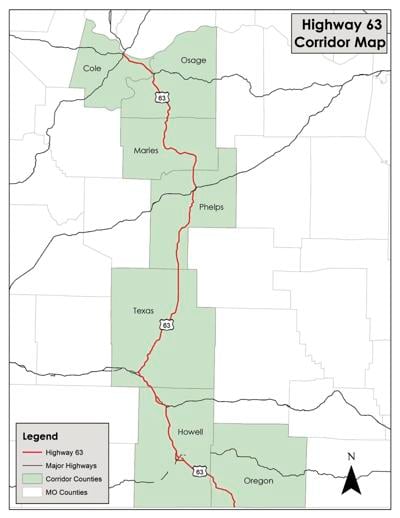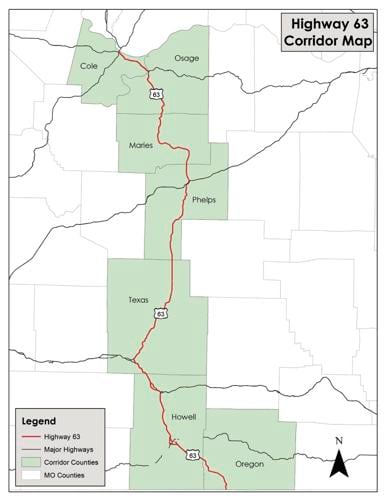Community leaders in Phelps County are joining with their regional counterparts to explore how long-wanted improvements of Highway 63 through South-Central Missouri can be achieved. Adding additional lanes and realigning the roadway in some sections has been a priority recommendation to MoDOT and the state legislature for more than a decade. However, with no new significant state investment, planners within the Highway 63 corridor are exploring alternative ways to secure the necessary funding.
“We have to come to the realization we are going to have to bring something to the table to make this happen. People are now accepting if we're going to get this done, we have to come up with a funding proposal to present MoDOT,” says West Plains City Administrator Tom Stehn. “Counting on MoDOT alone isn’t going to work. In the past, corridor improvements like ours could be funded by earmarks, but they don't have earmarks anymore. If we can come up with a cost-share proposal, we hope we can have a great partnership with MoDOT and move forward.”
Stehn is helping develop the idea not only as a West Plains civic leader but from the experience of being former MoDOT district engineer. As part of the proposed Highway 63 Alliance, he and other planners are studying the potential impact of making Highway 63 four lanes from Jefferson City to Arkansas. Included in that corridor are Cole, Osage, Maries, Phelps, Texas, Howell and Oregon counties.
“Right now, we're gathering data and developing our game plan,” Stehn says. “We've only had two meetings, but they've been productive, and we'd like to organize a nonprofit organization. We're probably a year or more away from actually giving MoDOT a proposal that we'd like to try to move forward with.”
Among the issues being studied by the group are preferred alignments, safety upgrades, potential economic and environmental impacts and different funding mechanisms.
“We will be looking at different scenarios from property taxes, sales tax, to special assessments, tolls, bonds, and at the federal level securing a BUILD Grant,” Stehn says. “All options are on the table. We’re trying to get more information and decide what is the best course of action for the corridor as a whole.”
Helping support the effort is the Meramec Regional Planning Commission and its counterpart, the South Central Ozark Council of Governments.
“Making Highway 63 four lanes all the way to Jefferson City is the number one priority in the Meramec region based on our Transportation Advisory Committee and the MRPC board,” says MRPC Executive Director Bonnie Prigge. “Highway 63 is really the primary north/south thoroughfare in our region of the state, so it’s a strategic route for the economics of moving freight and moving people.”
Prigge says initial data compiled by MRPC reveal that traffic on Highway 63 in the Meramec region continues to increase, and 67% of the people living in the seven-county area reside within five miles of the highway.
In terms of safety, Phelps County may have the most to gain in the Highway 63 corridor. Of the seven counties concerned, Phelps County recorded the most motor vehicle crashes from 2010 to 2019 with 2,541 total, plus 14 fatalities and 41 serious injuries. Across the entire region, there were 8,108 total crashes along the Highway 63 corridor from 2010 to 2019, plus 79 fatalities and 271 serious injuries.
“What it really comes down to is if the general public, the folks that drive the roads and purchase the goods, are willing to pay the additional sales tax to see an improved roadway,” Prigge says. “We say it’s the top priority for our region, but it really comes down to if people are willing to pay for it.”
Preliminary calculations by the Highway 63 Alliance indicate with conservative growth estimates a theoretical one-cent sales tax to fund the Highway 63 improvements through a seven-county Transportation Development District would generate around $28 million per year, or more than $300 million over 10 years with higher economic growth. That funding could be further leveraged through grants. For example, the federal BUILD grant comes with an 80/20 federal-local cost share.
“This is something that's been talked about for a long time, and there's been a couple of efforts over the last five to 10 years to raise the level of the conversation, but this seems like the most committed effort to start to build some consensus,” says Rolla City Administrator John Butz. “Areas like Poplar Bluff, Kirksville and other communities have, rather than waiting on MoDOT, come up with the funding to expand their two-lane state highways and formed these TDDs to proactively fund construction entirely themselves, or leverage matching funds to get those projects done in three to five years instead of 15 to 20.”
A similar multicounty regional TDD effort in Missouri was launched to four-lane US Highway 36 through Macon, Marion, Monroe, Shelby and Ralls counties. In that case, the improvements have increased safety and reduced travel times, and led to the roadway’s consideration of becoming an extension of Interstate 72.
Butz adds an overhaul of Highway 63 could also potentially breathe new life into the idea of creating a Highway 63 bypass around Rolla through building a fifth Interstate 44 interchange.
“I think that would be the city's position” Butz says. “It would only make sense to do this if we provided a mechanism for people who are just trying to transverse the state going from Arkansas to Iowa and relieve the congestion in our primary business corridor. We think a fifth interchange would have to be a really important part of that.”
Speaking from the experience of helping lead the Move Rolla TDD, Butz says planners with the Highway 63 Alliance should embrace long-range planning.
“It takes a lot of shared vision, it takes a lot of data, a lot of analysis, and then it takes a compelling argument as to why people should want to spend more tax dollars,” Butz says. “We should proceed cautiously, thoroughly and patiently. These things can take a long time. Here in Rolla, the Highway 72 Extension was actively on the drawing board for 20 years.”
Members of the Highway 63 Alliance are planning to hold additional meetings moving forward with nonprofit formation and initial fundraising as the next primary goals. If the necessary money is secured, additional studies will be commissioned to update environmental studies, draft updated cost estimates and collect new data which could be used in a grant application.
















